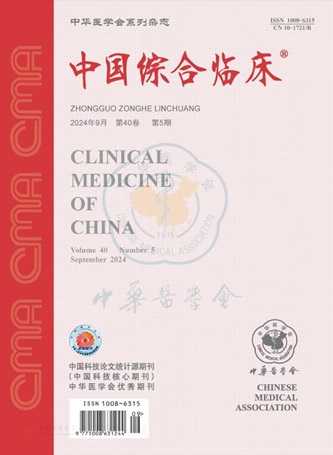Nutritional assessment of children with non-Hodgkinundefineds lymphoma during induced chemotherapy
引用次数: 0
Abstract
Objective To evaluate the nutritional status of children with non-Hodgkin lymphoma (NHL) during induction chemotherapy, and to understand the incidence of malnutrition, so as to give nutrition intervention in time. Methods From January 2017 to December 2018, 257 children with NHL were selected from the Center for Hematological Oncology, Peking Children′s Hospital Affiliated to Capital Medical University.Nutritional status and growth risk screening tools were used to assess the nutritional risk of the children, and the malnutrition was classified according to the height and body weight.The body mass, height and other anthropometric indexes, hemoglobin, prealbumin, albumin and other laboratory indexes were measured at the end of initial diagnosis and induction chemotherapy. Results There were 223 cases of moderate nutritional risk (86.8%) and 34 cases of high nutritional risk (13.2%). After treatment, the nutritional status of the children decreased: 13 cases of mild malnutrition, 1 case of moderate malnutrition, 4 cases of overweight and 3 cases of obesity before treatment; 32 cases of mild malnutrition, 9 cases of moderate malnutrition, 5 cases of severe malnutrition, 3 cases of overweight and 2 cases of obesity after treatment.Ninety-six patients received nutritional support (37.4%), including 15 cases of parenteral nutrition and 81 cases of enteral nutrition.The body weight ((29.50±15.13) kg before and after chemotherapy (27.60±14.30) kg) and body mass index ((17.2±3.28) kg/m2 before and (16.1±3.13) kg/m2 after chemotherapy) decreased significantly (t=12.404, 13.949, all P<0.01). Laboratory indicators except prealbumin were lower in hemoglobin ((109.00±15.78) g/L), albumin ((37.40±4.38) g/L), total lymphocyte ((1.58±1.26)×109/L) than before treatment (hemoglobin(117.90±21.06) g/L), (albumin (39.60±6.70) g/L), (total lymphocyte (2.98±2.87)×109/L)) (t=6.514, 4.834, 7.420, all P<0.01). Conclusion There is a high incidence of malnutrition in NHL children after initial treatment.Early screening of nutritional risk and optimizing nutritional treatment are one of the ways to improve the clinical efficacy of NHL children. Key words: Non-hodgkin′slymphoma; Nutritional assessment; Malnutrition; Pediatrics儿童非霍奇金淋巴瘤诱导化疗期间的营养评估
目的了解儿童非霍奇金淋巴瘤(NHL)诱导化疗期间的营养状况,了解营养不良的发生率,以便及时进行营养干预。方法2017年1月至2018年12月,从首都医科大学附属北京儿童医院血液肿瘤中心选取257名非霍奇金淋巴瘤患儿,采用营养状况和生长风险筛查工具对其营养风险进行评估,并根据身高和体重对营养不良进行分型。在初诊和诱导化疗结束时测量体重、身高等人体测量指标、血红蛋白、前白蛋白、白蛋白等实验室指标。结果儿童中营养风险223例(86.8%),高营养风险34例(13.2%),治疗后儿童营养状况下降:治疗前轻度营养不良13例,中度营养不良1例,超重4例,肥胖3例;治疗后轻度营养不良32例,中度营养不良9例,重度营养不良5例,超重3例,肥胖2例。96例患者接受了营养支持(37.4%),其中肠外营养15例,肠内营养81例。化疗前后体重(29.50±15.13)kg(27.60±14.30)kg)和体重指数(17.2±3.28)kg/m2和(16.1±3.13)kg/m2)均显著下降(t=12.404、13.949,均P<0.01),总淋巴细胞(1.58±1.26)×109/L)显著高于治疗前(血红蛋白(117.90±21.06)g/L)、(白蛋白(39.60±6.70)g/L、(总淋巴细胞(2.98±2.87)×109g/L)(t=6.514、4.834、7.420,均P<0.01)。早期筛查营养风险,优化营养治疗是提高NHL患儿临床疗效的途径之一。关键词:非霍奇金淋巴瘤;营养评估;营养不良;儿科学
本文章由计算机程序翻译,如有差异,请以英文原文为准。
求助全文
约1分钟内获得全文
求助全文
来源期刊
CiteScore
0.10
自引率
0.00%
发文量
16855
期刊介绍:
Clinical Medicine of China is an academic journal organized by the Chinese Medical Association (CMA), which mainly publishes original research papers, reviews and commentaries in the field.
Clinical Medicine of China is a source journal of Peking University (2000 and 2004 editions), a core journal of Chinese science and technology, an academic journal of RCCSE China Core (Extended Edition), and has been published in Chemical Abstracts of the United States (CA), Abstracts Journal of Russia (AJ), Chinese Core Journals (Selection) Database, Chinese Science and Technology Materials Directory, Wanfang Database, China Academic Journal Database, JST Japan Science and Technology Agency Database (Japanese) (2018) and other databases.

 求助内容:
求助内容: 应助结果提醒方式:
应助结果提醒方式:


